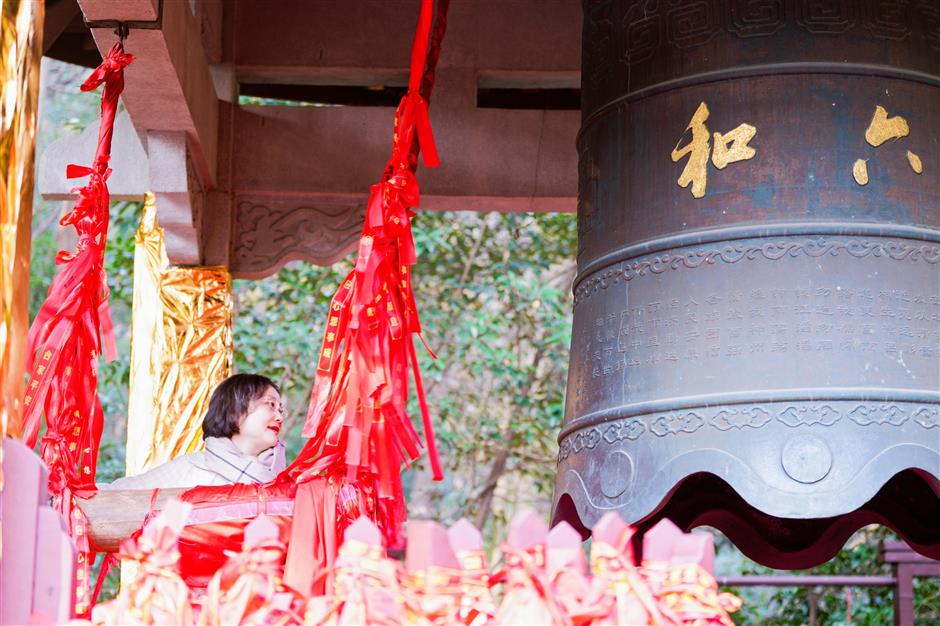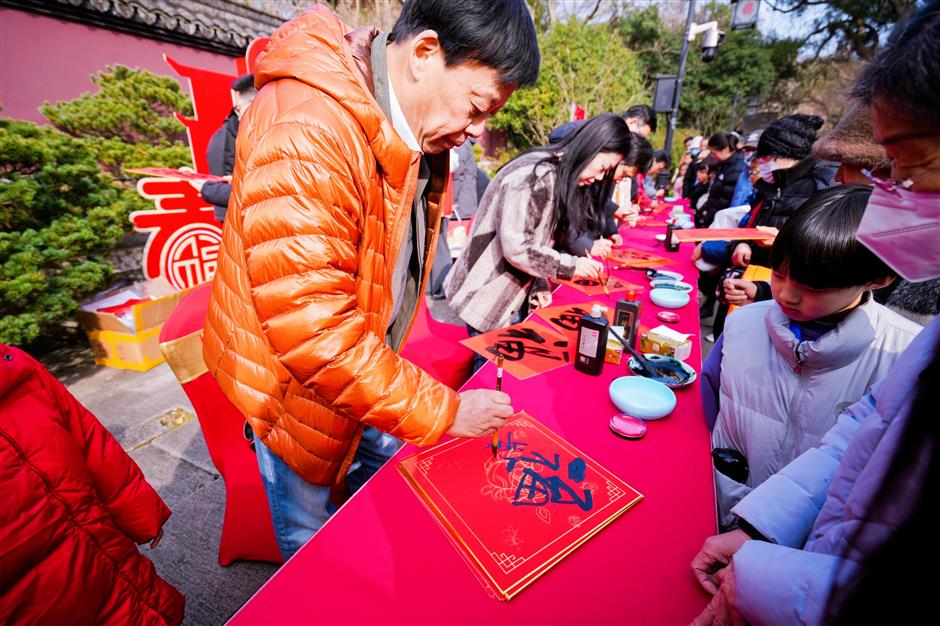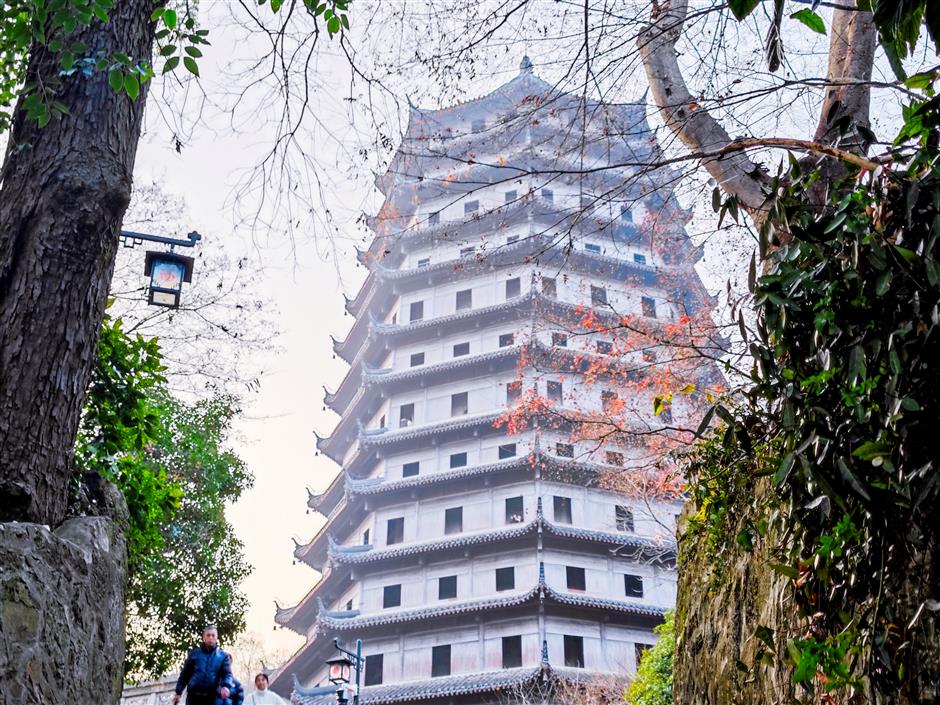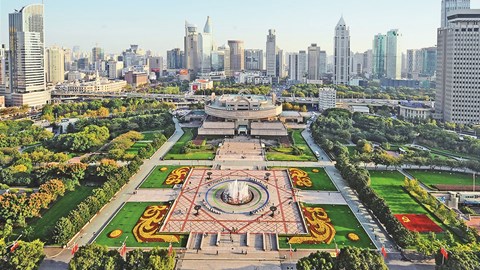New Year's festivities begin at Liuhe Pagoda
The Liuhe Pagoda ceremony marked the beginning of the New Year’s festivities in Hangzhou. On January 1, people customarily struck the large bell six times to pray for a bountiful crop and good fortune.
In Chinese philosophy, the six strikes represent six different types of bliss: tianhe (天和), dihe (地和), renhe (人和), jiahe (家和), yehe (业和), and shenhe (身和), which encompass well wishes in every way.
This year’s commemoration, which runs through February 16, has as its theme “美美与共,” which translates as “one should cherish the cultures of others.”
The organizers aim to encourage the younger generation to participate in festive traditions by offering a plethora of activities that explore the cultural heritage of Liuhe Pagoda.
The Chinese New Year customs often involve writing the character “福” on a red square piece of paper, and Liuhe Pagoda’s celebration is no different. Furthermore, dancers dressed in traditional garb present “General Liuhe,” a performance that extols the pagoda’s past.

A visitor strikes the giant Liuhe Pagoda bell to pray for a fruitful crop and a good new year.
In 2019, Miu Jingwen, a 20-year pagoda employee and commentator, wrote the song. Because of her wealth of experience and understanding of the pagoda, she worked with a local orchestra to create the music.
Red lanterns, symbolic of the Chinese New Year, now adorn the Liuhe Pagoda Cultural Park. Visitors are encouraged to participate in the activities on site and gather seal stamps to redeem gifts.
There’s also an exhibition about the pagoda’s architecture, history and archeological discoveries.
Liuhe is a Chinese philosophical term meaning “six harmonies.” The 13-story pagoda, made of brick and wood, is adorned with delicate patterns of flowers, creatures and Buddhist tales. Visitors can reach the roof via a spiral staircase that connects the odd-numbered floors.
The pagoda is located alongside the Qiantang River, which is home to the world’s largest tidal bore. As the tide surges into the river mouth from Hangzhou Bay, the waves reach a height of 5 meters.
The strong waves were a problem for people in ancient times. Until the Wuyue Kingdom achieved a breakthrough during the Five Dynasties and Ten Kingdoms period (AD 907-979), the flooding continued. Building the “great seawall” between the city and the water was Emperor Qianliu’s wise investment that turned Hangzhou into a thriving metropolis.
Qianliu also presided over the construction of the Liuhe Pagoda, which was supposed to “calm” the tidal bores. The royal court held rituals to worship the god of tides, seeking divine intervention in harnessing the tides.

Visitors write the Chinese character “福 (blessing or good fortune)” on a red square paper at the Liuhe Pagoda Culture Park.
Often referred to as the god of tides, Wu Zixu was an upright and wise general and politician in the State of Wu (modern-day Zhejiang and Jiangsu provinces, along with Shanghai) during the Spring and Autumn Period (770–476 BC).
Wu dug rivers and constructed dams, earning him the nickname “the tide’s incarnation.”
The royal family, imperial officials and the populace would assemble at Liuhe Pagoda on the 18th day of the eighth lunar month to worship Wu, a tradition that started during the Song Dynasty (960–1279).
Today, an exhibition introducing the natural phenomenon will take place in September and October as part of the ritual.
The pagoda is also a garden to linger over flowers as well as a place to offer prayers. Dating back to the Wuyue Kingdom, it was established as a royal court that was dedicated to cultivating peonies.
Hangzhou celebrated the ancient Huazhao Festival with flower-themed celebrations when it became the capital of the Southern Song Dynasty (1127–1279).
The event, which falls on the 12th day of the second lunar month, honors the birthday of the flower goddess.
In the past, families would go on outings to enjoy the flowers on the most vibrant day of the year. One of the highlights of the yearly flower festival was the blooming peonies at the Liuhe Pagoda.

If you go
Liuhe Pagoda Cultural Park
Admission: 20 yuan (US$2.8)
Address: 16 Zhijiang Rd
















